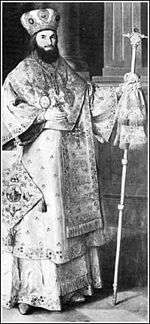Teodor Ilić Češljar

Teodor Ilić Češljar (Serbian Cyrillic: Теодор Илић Чешљар) was born in 1746 in Čurug, Serbia and died on November 20, 1793 at age 47 in Bačko Petrovo Selo (now Serbia). He was a late Baroque Serbian painter from Vojvodina best known for being the creator of the Royal Doors from Ostojićevo. It is assumed that he learned to paint from famous masters of Timişoara and Novi Sad, where he lived in 1769.
His first known work was a painting of four evangelists on church belfry in Buda in 1776 on which he worked together with Mihael Skokolović. According so some older biographers, Češljar enrolled in Academy of Fine Arts Vienna in 1786.
He worked on his first iconostasis in 1789 in church of Mokrin; after that he worked in Velika Kikinda and Stara Kanjiža in 1791, and in Bačko Petrovo Selo from 1792 to 1793, when he died. Alongside he has drawn several icons for lower church in Sremski Karlovci and iconostasis of Kovilj monastery which was destroyed in 1848.
According to quotes from Teodor Ilić Češljar biographies, he was a great colorist and exceptionally inventive in composure. He didn't always paint in style of baroque. He, as his coeval, leaned to softer and more gentle colours, silky facture glaze painting just like French masters of rococo.
There is no accurate information about portraits painted by Teodor Ilić Češljar, but it is certain that his works include portraits of Pavle Avakumović (1789), portrait of an unknown priest (National Museum of Serbia), portrait of Jovan Jovanović Šakabenta (1787, Museum of Vršac) and large number of ecclesiastical portraits. Another portrait of Jovan Jovanović Šakabenta is also attributed to Jakov Orfelin.
On these portraits, Češljar proved to be a master of drawing and also a subtle and aesthetic colorist as he did with icons. The only exception is rather conventional and cold portrait of Jovan Jovanović Šakabenta.
His famous painting of Saint Barbara Anguish (1785) was drawn for bishop of Nagyvárad. It shows his great sense of composition. This canvas is reminiscent of Venetian decorative painters.
Two wall painting in Kikinda show even more intentions for Venetian painting. They are The Last Supper and Christ in Eclat, masterpieces of Serbian baroque painting.
A street in Kikinda is named after him.